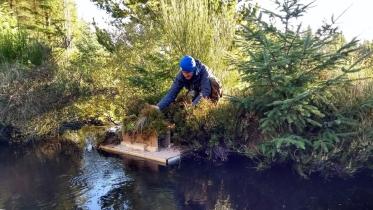Scottish Health Survey 2019 - Headline findings on physical activity, health and well-being
Background
The Scottish Health Survey (SHeS) is commissioned by the Scottish Government to provide data on the health and lifestyles of the Scottish population. The survey has been run on an annual basis since 2008 with earlier single year surveys undertaken in 1995, 1998 and 2003. Scotland-level data are available annually and can be disaggregated by population sub-group. NHS Health Board-level data are available every four years.
A Scottish Health Survey Annual Report is published each year, covering the previous calendar year’s research findings. This short paper provides headline findings from the Scottish Health Survey for 2019 (published in September 2020), focusing on the topics of most interest to NatureScot, i.e. physical activity levels and the general health and well-being of the Scottish population. Please note that the 2019 SHeS does not capture the impact of the subsequent COVID-19 pandemic on the physical and mental well-being of the Scottish population; this will be covered in the 2020 survey.
SHeS questions on participation in physical activity
The latest UK-wide physical activity guidelines were published on 7 September 2019.
Those for adults aged 19-64 recommend daily physical activity comprising:
- At least 150 minutes (2½ hours) of moderate intensity activity each week (e.g. brisk walking or cycling);
- Or 75 minutes of vigorous intensity activity each week (e.g. running);
- Or even shorter durations of very vigorous intensity activity each week (e.g. sprinting, stair climbing);
- Or a combination of moderate, vigorous and very vigorous activity each week.
- Sedentary time should be minimised as far as possible.
Those for adults aged 65 and over recommend daily physical activity comprising:
- At least 150 minutes (2½ hours) of moderate intensity activity each week, gradually building up to this where activity levels are currently low.
- For those who are already active, 75 minutes of moderate and vigorous activity each week.
- On at least two days of the week, activities aimed at maintaining or improving muscle strength, balance and flexibility.
- Weight-bearing activities to help maintain bone health.
- Where physically able, long periods of being sedentary should be broken up with light activity or with standing.
The adult guidelines are referred to as the MVPA guidelines, i.e. Moderate or Vigorous Physical Activity.
To monitor adherence to the adult MVPA guidelines in Scotland, the SHeS asks respondents about four main types of physical activity:
- Home-based activity (i.e. housework, gardening, building work and DIY)
- Walking
- Sports and exercise
- Activity at work
Information is collected on the time spent being active; the intensity of activities undertaken; and the frequency with which activities are undertaken.
Physical activity guidelines for children and young people aged 5-18 recommend:
- An average of 60 minutes of moderate to vigorous physical activity per day1, involving engagement in a range of activities and intensities over the course of a week.
- As minimal an amount of sedentary time as possible, with long periods of inactivity broken up with physical activity.
To monitor adherence to children’s physical activity guidelines, the SHeS asks about three main types of physical activity (undertaken in school and outside of a school setting)
- Sports and exercise
- Active play
- Walking
No information on intensity of activities is collected with the exception of asking 13-15 year olds about their walking pace.
Children’s physical activity was not reported on in the 2018 SHeS but has been included again in the 2019 report.
Headline finding for 2019
Adult physical activity
- In 2019, 66% of adults met the recommendations for Moderate or Vigorous Physical Activity (MVPA). The proportion meeting MVPA guidelines in 2019 was the same as in 2018 and has not changed significantly since 2013 (remaining in the range 63%-66%).
- Among the 34% of adults who did not meet recommended levels of MVPA in 2019, 11% had participated in ‘some’ physical activity (defined as between 60 and 140 minutes of moderate activity or 75 minutes of vigorous activity per week); 3% had participated in ‘low’ activity (between 30 and 59 minutes of moderate activity or between 15 and 29 minutes of vigorous activity per week); and 20% had participated in ‘very low’ activity (less than 30 minutes of moderate activity or less than 15 minutes of vigorous activity per week).
- In 2019, men remained significantly more likely than women to meet recommended levels of MVPA (71% and 61%, respectively) and this was true across all age groups.
- Physical activity levels for both men and women were significantly associated with age, with younger adults more likely than older adults to meet recommendations. Adherence to the guidelines in 2019 was highest among those aged 25-34 (77%), declining thereafter to 55% among 65-74 year olds and to 35% among those age 75 and over.
- Older adults were more likely than younger adults to have ‘very low’ levels of physical activity (e.g. 48% of those aged 75 and above compared to between 12%-14% of those aged 16-54 undertook less than 30 minutes of moderate activity or less than 15 minutes of vigorous activity per week).
- Adult physical activity levels remain significantly associated with area deprivation2. The proportion of adults active at the recommended level of MVPA declined steadily as deprivation increased, from 74% among those living in the 20% least deprived areas in Scotland to 54% among those living in the 20% most deprived areas in Scotland. This pattern has been evident since 2012 and can be attributed almost entirely to levels of ‘very low’ activity among those in the most deprived areas (e.g. in 2019, 13% of those living in the 20% least deprived areas compared to 32% of those living in the 20% most deprived areas undertook less than 30 minutes of moderate activity or less than 15 minutes of vigorous activity per week).
- In 2019, adults recorded an average of 5.4 hours of sedentary leisure time per day on week days, increasing to an average of 6.2 hours per day at weekends. Similar patterns were recorded for both men and women. Levels of sedentary leisure time varied significantly by age with those aged 25-54 recording the lowest levels.
- Adult physical activity is undertaken in a variety of settings3 with ‘local pavements and streets’ (used by 86% of active adults) and ‘homes/gardens’ (used by 82% of active adults) most popular. In addition, a significant amount of adult physical activity takes place in green and blue spaces such as ‘open spaces or parks’ (32% of active adults), ‘woods/forests/tree-covered parks’ (31%), ‘country paths’ (24%) and ‘beaches/sea shore/lochs/rivers/canals’ (20%). Around a fifth of active adults had used a ‘gym/sports centre’ (22%) and smaller proportions had used a ‘swimming pool’ (13%) or a ‘sports field/outdoor court’ (8%).
In 2018 the SHeS included a number of questions on motivations and barriers to physical activity (these questions were not included in the 2019 survey).
- In 2018 the most common reasons cited by adults for participating in physical activity were: to keep fit (68%), for enjoyment (63%), to de-stress, relax and unwind (44%), for health reasons (36%) and to socialise (32%). The reasons people gave for participating in physical activity varied with gender and age.
- In 2018 the most common barriers to participation among those who had not undertaken any physical activity in the previous month were: lack of time (30%), poor health (30%) and lack of interest (17%). Some of these barriers varied significantly with age, for example, poor health was more likely to be cited as a barrier among older people and lack of time was more likely to be cited as a barrier by younger people.
Child physical activity
- In 2019, 69% of children aged 2-154 were physically active at the recommended level for an average week, a significant decrease on 2016 (76%) and the lowest level reported in the time series (previous estimates have been in the range 70% to 76%). The decrease reported in 2019 appears to have been driven by a drop in activity levels among boys (71% of boys met physical activity guidelines in 2019, compared to 79% in 2016). No significant decrease was recorded for girls. The picture was very similar when school-based physical activity was excluded from the analysis.
- The proportion of girls meeting recommended levels of physical activity remains lower than for boys (68% and 71% in 2019, respectively).
- In 2019, physical activity levels among children varied significantly by age, with levels of adherence to guidelines highest among 8-10 year olds (79% met recommended guidelines) and 5-7 year olds (78%). The lowest levels of adherence to guidelines were among 13-15 year olds (53%).
- In 2019, 66% of children aged 2-15 had participated in sport in the week prior to interview, similar to the level reported in 2017 (67%). There was no significant variation in participation between boys and girls (67% and 66%, respectively, participated). Participation did, however, vary by age, increasing from 52% among 2-4 year olds, to between 71% and 78% among 5-12 year olds before decreasing to 60% among 13-15 year olds. This pattern was similar among both boys and girls.
- On average, children spent more time being sedentary at weekends (4.9 hours per day) than on week days (3.6 hours per day) in 2019. Time spend on sedentary leisure activities was significantly associated with children’s physical activity levels: children who met physical activity recommendations spent less time on sedentary leisure activities on both week days and at weekends than those who engaged in lower levels of physical activity.
- Children’s physical activity is undertaken in a variety of settings5, with ‘local pavements and streets’ (used by 92% of active children) and ‘homes/gardens’ (used by 77% of active children) most popular. In addition, a significant amount of children’s physical activity takes place in green and blue spaces such as ‘playgrounds or parks’ (51% of active children), ‘open spaces/parks’ (48%), ‘woodland’ (39%), ‘country paths’ (22%) and ‘beaches/rivers (22%). Around a third of active children had visited a ‘swimming pool’ (35%) and around a quarter had visited a ‘gym/sports centre’ (26%) or a ‘sports field/outdoor court’ (25%).
Adult self-assessed health
- In 2019, 72% of adults described their general health as either ‘good’ (39%) or ‘very good’ (33%), 19% described it as ‘fair’ and 9% described it as ‘bad’ (7%) or ‘very bad’ (2%). The proportion of adults reporting ‘good’ or ‘very good’ health in 2019 (72%) is similar to 2018 (71%) but has gradually reduced over the last ten years or so from a high of 77% in 2009. The level of self-assessed ‘bad’ or ‘very bad’ health has remained stable since 2008 (in the range 7% to 9%).
- Men and women have reported broadly similar levels of health since 2008 although in 2019 men were more likely than women to describe their general health as ‘good’ or ‘very good’ (74% and 70%, respectively).
- As in previous survey years, the proportion of adults describing their health as ‘good’ or ‘very good’ in 2019 declined with age, from 85% among 16 to 24 year olds to 54% among those aged 75 and over. Conversely, self-reported bad health increased with age, from 4% of 16 to 24 year olds to 17% of those aged 75 and over. The same general patterns were evident for men and women, although women aged 16-24 were less likely to report that their health was ‘good’ or very good’ than men in the same age group (80% and 89%, respectively).
- The age standardised6 proportion of adults reporting their general health as ‘good’ or ‘very good’ was highest for those living in the 20% least deprived areas (83%) and lowest for those living in the 20% most deprived areas (54%). Conversely, people living in the 20% most deprived areas were more likely to describe their health as ‘bad’ or ‘very bad’ (20%) than those living in the 40% least deprived areas (between 4% and 5%).
- In 2019, 95% of children in Scotland were reported as being in ‘very good’ (70%) or ‘good’ health (25%) and 5% were reported as being in ‘fair’ health. There was no significant difference between the proportions of boys and girls reported as being in ‘good’ or ‘very good’ health. Only 1% of children had ‘bad’ or ‘very bad’ health. These levels are consistent with those reported since 2008.
Mental well-being
The average WEMWBS7 (Warwick – Edinburgh Mental Wellbeing Scale) score is used to monitor the National Indicator on mental well-being and the mean score of parents of children aged 15 years and under is included in the mental health indicator set for children.
- In 2019, the level of mental well-being in the population, as measured by the WEMWBS, was 49.8, the same as that recorded in 2017 and not significantly different from 2018 (49.4). Across the time series as a whole (baseline year 2008), WEMWBS mean scores have ranged from 49.4 to 50.0. In 2019, the mean WEMWBS scores for men and women were similar at 49.9 and 49.7, respectively. WEMWBS scores for men and women have shown some variation across the time series, with average scores for men in the range 49.3 – 50.4 and for women in the range 49.4 – 49.9.
- As in previous years, WEMWBS mean scores varied significantly by age, with scores higher among older adults (52.0 for those aged 65-74 and 50.4 for those aged 75 and over) and lower among younger adults (in the range 49.1 to 49.7 for those aged between 16 and 64). Similar patterns were evident for both men and women with no significant variations by gender.
- Positive mental well-being continues to be associated with area deprivation: as area deprivation increases, the age-standardised8 WEMWBS mean score decreases. In the 20% most deprived areas, the mean WEMWBS score in 2019 was significantly lower (46.9) than in 20% least deprived areas (51.5).
- In 2018/199, adults who met the MVPA (physical activity) guidelines had a higher WEMWBS mean score than those who did not (50.8 and 47.4, respectively).
- The WEMWBS mean score for children age 13-15 for 2016- 201910 combined was 51.0, the same as that reported for 2012 – 2015 combined. As in 2012 -2015, the WEMWBS score for boys in 2016-2019 was significantly higher than the score for girls (52.0 and 49.9, respectively). There was no clear pattern for the WEMWBS mean scores for children by area deprivation for 2016 – 2019 combined.
Overweight and obesity
- In 2019, only 34% of adults were in the healthy weight category. Women (37%) were significantly more likely than men (31%) to be in the healthy weight range.
- A majority of adults were overweight in 2019 (66%), including 29% who were obese. There has been a gradual increase since 2011 in the proportion of adults in Scotland who are overweight (including obese) and prevalence is now at its highest level in the time series (e.g. 62% of adults were overweight, including obese, in 2003). The prevalence of obesity among adults in Scotland has remained relatively stable since 2008 (fluctuating between 27% and 29%).
- Men have been consistently more likely than women to be overweight or obese (65% - 69% of men since 2003 compared to 60% - 63% of women). There has been little difference in the prevalence of obesity among men and women since 2008 (between 26% - 29% for men and 27% - 30% for women).
- Both obesity and being overweight remain significantly associated with age, with levels generally higher among older people: 40% of 16 to 24 year olds were overweight or obese in 2019 compared to 79% of those aged 65-74 and 71% of those aged 75 plus. A similar pattern was observed in both men and women.
- In 2019, 68% of children aged between 2 and 15 were within a healthy weight range. The proportion of children in the healthy weight range has remained fairly stable since the beginning of the time series in 1998, with the lowest prevalence occurring in 2011 (65%) and a range of 68% - 72% recorded since 2012.
- In 2019 there was no significant difference in the proportion of boys and girls in a healthy weight range (66% boys and 70% of girls). The proportion of girls in a healthy weight range has remained relatively stable since 1998 while there have been relatively large fluctuations in the proportion of boys in a healthy weight range over the same period.
- The highest proportion of children aged 2 – 15 in the healthy weight range was among those aged 7-11 (73%), and the lowest among those aged 12-15 (62%).
- In 2019, just under a fifth of children (16%) were at risk from obesity, with similar proportions observed for boys and girls.
Long-term conditions
- The proportion of adults with a long-term condition or illness lasting or likely to last 12 months or more has remained stable since 2012.
- In 2019, almost half of adults in Scotland reported living with a long-term health condition (47%). Women were more likely than men to have a long-term condition (49% and 46%, respectively).
- The prevalence of long-term health conditions increased steadily with age (e.g. 29% of 16-24 year olds had a long-term condition compared to 73% of those aged 75 and over). This pattern was similar for both men and women.
- The prevalence of long-term health conditions was also associated with area deprivation. As area deprivation increased, the age-standardised11 proportion of adults with a long-term condition also increased (e.g. 38% of adults living in the 20% least deprived areas had a long-term health condition compared to 58% of those living in the 20% most deprived areas).
- The majority of those with a long-term health condition lived with a limiting condition. More than a third of adults in 2019 lived with a limiting long-term condition (35%), with women more likely to do so than men (37% and 32%, respectively).
- In 2019, 19% of children aged 0–15 had a long-term health condition.
1 Although the recommendation applies to children aged five and over, the figures reported in the SHeS relate to children aged 2-15 for consistency with figures reported in previous years.
2 Age standardisation is used to adjust for the effects which differences in the age distribution within each SIMD quintile may have, enabling comparisons between quintiles to be made.
3 Data for 2017 and 2019 have been combined to provide a larger sample of respondents for analysis.
4 Although the recommendation to engage in moderate-to-vigorous intensity physical activity for an average of at least 60 minutes per day applies to children aged five and over, this analysis relates to those aged 2-15 to provide consistency with figures reported in previous years.
5 Data for 2017 and 2019 have been combined to provide a larger sample of respondents for analysis.
6 Age standardisation is used to adjust for the effects which differences in the age distribution within each SIMD quintile may have, enabling comparisons between quintiles to be made.
7 The Warwick-Edinburgh Mental Well-being Scale (WEMWBS) was developed by Warwick and Edinburgh Universities for NHS Health Scotland in 2006. It uses a set of 14 positively worded statements, with a five-point response scale, to assess a population´s mental wellbeing (the higher the score, the more positive the population's mental health). The highest possible score is 70 and the lowest possible score is 14.
8 Age standardisation is used to adjust for the effects which differences in the age distribution within each SIMD quintile may have, enabling comparisons between quintiles to be made.
9 Data from the 2018 and 2019 have been combined to provide a larger sample of respondents for analysis.
10 Data for 2016 – 2019 have been combined to provide a larger sample of respondents for analysis.
11 Age standardisation is used to adjust for the effects which differences in the age distribution within each SIMD quintile may have, enabling comparisons between quintiles to be made.
Published: November 2020





